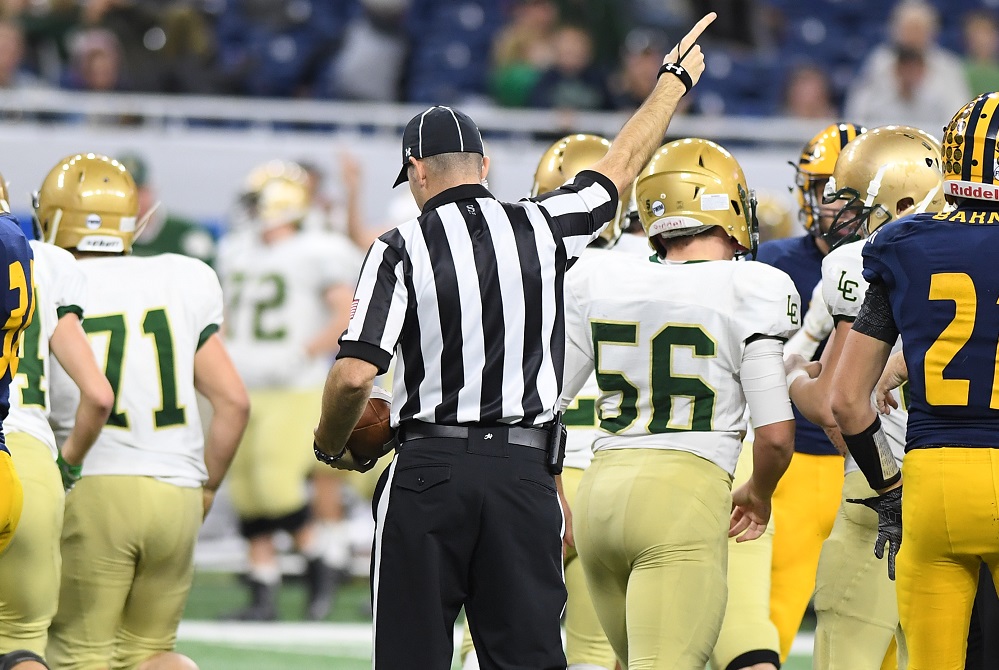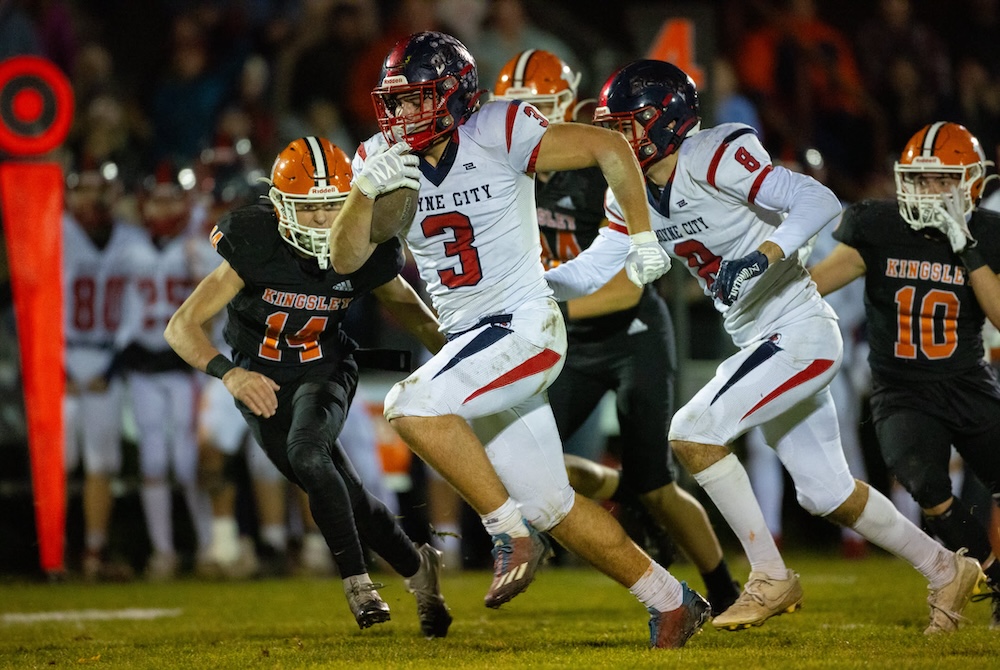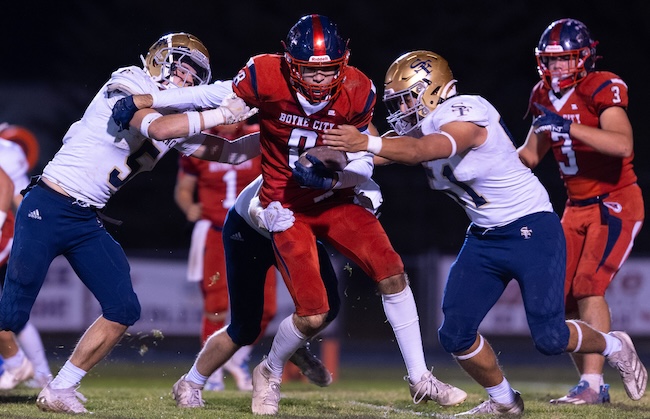
Be the Referee: Pass Interference
By
Geoff Kimmerly
MHSAA.com senior editor
September 2, 2021
This week, MHSAA officials coordinator Sam Davis explains the differences in high school pass interference rules from those at the college and pro levels.
Be The Referee is a series of short messages designed to help educate people on the rules of different sports, to help them better understand the art of officiating, and to recruit officials.
Below is this week's segment – Pass Interference – Listen
One of the big differences between high school football and the college or pro game is how pass interference is called.
In high school, there is no such thing as an “uncatchable” pass. If there is illegal contact by the defender while the ball is in the air, that’s pass interference, no matter where the pass ultimately ends up.
Also – in high school – a defender can “face guard” as long as no contact is made with the receiver. That is not pass interference, even if the defender does not look back for the ball.
Both of those interpretations differ from the college and pro game. Both (of those) levels have an uncatchable exception, and neither allows for face guarding.
Keep that in mind the next time you think you’ve spotted pass interference at the high school level.
Previous editions
Aug. 26: Protocols and Mechanics – Listen

Surge Becoming Storied as Boyne City Continues Memorable Playoff March
By
Tom Spencer
Special for MHSAA.com
November 22, 2024
Not many would say Boyne City’s football team followed the script this season.
 After the way the Ramblers started this fall, only a scriptwriter could have envisioned the season they’ve enjoyed.
After the way the Ramblers started this fall, only a scriptwriter could have envisioned the season they’ve enjoyed.
Boyne City started with just 17 varsity players in August. After moving up some from the JV squad and losing their opener to Standish-Sterling 33-14, the Ramblers picked up a couple of wins. They then fell in Week 4 to Kingsley, last year’s Division 6 champion, 26-20.
But that’s where the losses stopped. Boyne City is on an eight-game winning streak – which included a 21-15 victory over Kingsley in the District Final two weeks ago.
And when the Ramblers found themselves down 14-0 to Reed City midway through the second quarter last week in their Division 6 Regional Final, nobody would have blamed them for abandoning the script.
But if there is one, it called junior Owen Hewitt’s number. He took over, scoring four touchdowns to lead Boyne to a 35-28 win that advanced the Ramblers to Saturday’s Semifinal against Lansing Catholic.
 “It wasn’t a dire situation,” said Boyne City coach Dave Suttle. “Our quarterback Drew Neer all year long has run our offense very well, and when we need a big play he’s always there. We threw a little curl, dig route over the middle to Owen and he went 63 yards for the score and kind of rejuvenated our team.”
“It wasn’t a dire situation,” said Boyne City coach Dave Suttle. “Our quarterback Drew Neer all year long has run our offense very well, and when we need a big play he’s always there. We threw a little curl, dig route over the middle to Owen and he went 63 yards for the score and kind of rejuvenated our team.”
Neer, also a junior, has connected with Hewitt and senior Jaden Alger the most this season. Hewitt’s first TD came with 1:22 left in the first half. Hewitt’s second was Boyne’s first offensive play of the second half and tied the game at 14-14.
It may have been Suttle scripting Hewitt’s performance.
Suttle expected Reed City to focus on stopping senior running back Ryan Spade, who has nearly 1,800 yards on the ground this season.
“Owen looked too good in practice last week, and we knew Owen was going to have a game,” Suttle said. “They were keying so hard on Ryan. We figured this was going to be the week, and we put some things in the game plan for him.”
Hewitt was extremely fired up coming out of halftime break, the sixth-year coach noted.
“Owen’s been our big-play guy all year,” said Suttle. “He’s got probably 600 yards receiving, and I think he’s scored 15 touchdowns between receiving and rushing. He’s been there but hadn’t had that wow game yet, that ‘Hey, who is this kid?’ And that was his game.”
The tough times this season from the small numbers to early losses united the team and created success, their coach proudly noted.
 “From football specifically, we have made lifelong friends,” Suttle said. “We’ve learned how to help other people and depend on each other. The boys keep throwing out there they truly feel like they are all one family now. There’s all kinds of kids in this group. They have each other’s back. They’re not looking to blame anybody or point fingers. They’re just a solid group of gritty kids.”
“From football specifically, we have made lifelong friends,” Suttle said. “We’ve learned how to help other people and depend on each other. The boys keep throwing out there they truly feel like they are all one family now. There’s all kinds of kids in this group. They have each other’s back. They’re not looking to blame anybody or point fingers. They’re just a solid group of gritty kids.”
Defensively, the Ramblers also have been led by Spate. He’s been involved in nearly 100 tackles. Sophomore Hyker McKinney has been involved in more than 70 tackles and Alger, junior Thomas Ager, senior Ryan Chapp, Hewitt and sophomore Ben Stanek are right behind them in solo tackles and assists.
Chapp and senior Leon Xiong have anchored the defensive line for the third straight year, Suttle pointed out.
“They’ve really stepped up this year, and they have pretty good stats,” Suttle said. “They are big-time leaders.”
The offensive line, in particular seniors Wiley Belcher and Zach Herrick, also continue to impress.
“They keep getting better every week and just keep pushing on,” Suttle said.
Win or lose this week or next, this team’s legacy already is solidified.
“I want this group to be remembered as the group that may have been counted out by a lot of other people or may have been overlooked,” Shuttle indicated. “We have a pretty good tradition of having a winning program, and we’ll make the playoffs and things like this, but this team sticks together and gets through the rough times and just never gives up.”
 Tom Spencer is a longtime MHSAA-registered basketball and soccer official, and former softball and baseball official, and he also has coached in the northern Lower Peninsula area. He previously has written for the Saginaw News, Bay County Sports Page and Midland Daily News. He can be reached at [email protected] with story ideas for Manistee, Wexford, Missaukee, Roscommon, Ogemaw, Iosco, Alcona, Oscoda, Crawford, Kalkaska, Grand Traverse, Benzie, Leelanau, Antrim, Otsego, Montmorency, Alpena, Presque Isle, Cheboygan, Charlevoix and Emmet counties.
Tom Spencer is a longtime MHSAA-registered basketball and soccer official, and former softball and baseball official, and he also has coached in the northern Lower Peninsula area. He previously has written for the Saginaw News, Bay County Sports Page and Midland Daily News. He can be reached at [email protected] with story ideas for Manistee, Wexford, Missaukee, Roscommon, Ogemaw, Iosco, Alcona, Oscoda, Crawford, Kalkaska, Grand Traverse, Benzie, Leelanau, Antrim, Otsego, Montmorency, Alpena, Presque Isle, Cheboygan, Charlevoix and Emmet counties.
PHOTOS (Top) Boyne City’s Ryan Spade (3) breaks into the open during his team’s 21-15 District Final win over Kingsley. (Middle) Ben Stanek (8) works to break free from a pair of Traverse City St. Francis defenders during a 23-20 Week 9 win over Traverse City St. Francis. (Below) Ramblers coach Dave Suttle, middle, raises the District championship trophy with senior Leon Xiong (11) and junior Owen Hewitt (14). (Photos by Brandon Kish.)

